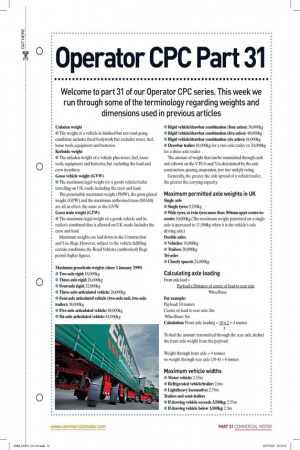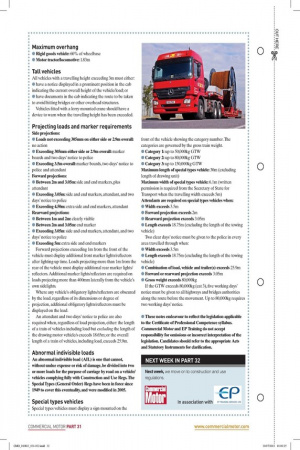Operator CPC Part 31 Welcome to part 31 of our
Page 25

Page 26

If you've noticed an error in this article please click here to report it so we can fix it.
Operator CPC series. This week we run through some of the terminology regarding weights and dimensions used in previous articles Unladen weight • The weight of a vehicle in finished but not road-going condition; includes fixed bodywork but excludes water, fuel, loose tools, equipment and batteries.
Kerbside weight • The unladen weight of a vehicle plus water, fuel, loose tools, equipment and batteries, but excluding the load and crew members.
Gross vehicle weight (GVW) • The maximum legal weight for a goods vehicle/trailer travelling on UK roads, including the crew and load.
The permissible maximum weight (PMVV), the gross plated weight (GPW) and the maximum authorised mass (MAM) are all, in effect, the same as the GVVV.
Gross train weight (GTW) • The maximum legal weight of a goods vehicle and its trailer/s combined that is allowed on UK roads. Includes the crew and load.
Maximum weights are laid down in the Construction and Use Regs. However, subject to the vehicle fulfilling certain conditions, the Road Vehicles (authorised) Regs permit higher figures.
Maximum gross/train weights (since 1 January 1999) • Two-axle rigid: 18,000kg • Three-axle rigid: 26,000kg • Four-axle rigid: 32,000kg • Three-axle articulated vehicle: 26,000kg • Four-axle articulated vehicle (two-axle unit, two-axle trailer): 38,000kg • Five-axle articulated vehicle: 40,000kg • Six-axle articulated vehide: 44,000kg • Rigid vehicle/drawbar combination (four axles): 36,000kg • Rigid vehicle/drawbar combination (five axles): 40,000kg • Rigid vehicle/drawbar combination (six axles): 44,000kg • Drawbar trailer: 18,000kg for a two-axle trailer or 24,000kg for a three-axle trailer The amount of weight that can be transmitted through each axle (shown on the VTG 6 and 7) is determined by the axle construction, spacing, suspension, tyre size and ply rating.
Generally, the greater the axle spread of a vehicle/trailer, the greater the carrying capacity.
Maximum permitted axle weights in UK Single axle • Single tyres: 9,200kg • Wide tyres, or twin tyres more than 300nun apart centre-tocentre: 10,000kg (The maximum weight permitted on a single axle is increased to 11,500kg when it is the vehicle's sole driving axle) Double axles • Vehicles: 19,000kg • Trailers: 20,000kg Tr-axles • Closely spaced: 24,000kg Calculating axle loading Front axle load = Payload x Distance of centre of load to rear axle Wheelbase For example: Payload: 10 tonnes Centre of load to rear axle: 2m Wheelbase: 5m Calculation: Front axle loading = 10 x 2 =4 tonnes 5 To find the amount transmitted through the rear axle, deduct the front axle weight from the payload: Weight through front axle =4 tonnes so: weight through rear axle (10-4) =6 tonnes Maximum vehicle widths • Motor vehicle: 2.55m • Refrigerated vehicle/trailer: 2.6m • Light/heavy locomotive: 2.75m Trailers and semi-trailers • If drawing vehicle exceeds 3,500kg: 2.55m • If drawing vehicle below 3,500kg: 2.3m Maximum overhang • Rigid goods vehicle: 60% of wheelbase • Motor tractor/locomotive: 1.83m Tall vehicles All vehicles with a travelling height exceeding 3m must either: • have a notice displayed in a prominent position in the cab indicating the current overall height of the vehicle/load; or • have documents in the cab indicating the route to be taken to avoid hitting bridges or other overhead structures. Vehicles fitted with a lorry-mounted crane should have a device to warn when the travelling height has been exceeded.
Projecting loads and marker requirements Side projections: • Loads not exceeding 305mm on either side or 2.9m overall: no action • Exceeding 305nun either side or 2.9m overall: marker boards and two days' notice to police • Exceeding 3.5m overall: marker boards, two days' notice to police and attendant Forward projections: • Between 2m and 3.05m: side and end markers, plus attendant • Exceeding 3.05m: side and end markers, attendant, and two days' notice to police • Exceeding 4.50m: extra side and end markers, attendant Rearward projections: • Between lm and 2m: clearly visible • Between 2m and 3.05m: end marker • Exceeding 3.05m: side and end markers, attendant, and two days' notice to police • Exceeding 5m: extra side and end markers Forward projections exceeding lm from the front of the vehicle must display additional front marker lights/reflectors after lighting-up time. Loads projecting more than lm from the rear of the vehicle must display additional rear marker lights/ reflectors. Additional marker lights/reflectors are required on loads projecting more than 400mm laterally from the vehicle's own sidelights.
Where any vehicle's obligatory lights/reflectors are obscured by the load, regardless of its dimensions or degree of projection, additional obligatory lights/reflectors must be displayed on the load.
An attendant and two days' notice to police are also required when, regardless of load projection, either: the length of a train of vehicles including load but excluding the length of the drawing motor vehicle/s exceeds 18.65m; or the overall length of a train of vehicles, including load, exceeds 25.9m.
Abnormal indivisible loads An abnomial indivisible load (AIL) is one that cannot, without undue expense or risk of damage, be divided into two or more loads for the purpose of carriage by road on a vehicle/ vehicles complying fully with Construction and Use Regs. The Special Types (General Order) Regs have been in force since 1949 to cover this eventuality, and were modified in 2005.
Special types vehicles Special types vehicles must display a sign mounted on the front of the vehicle showing the category number. The categories are governed by the gross train weight.
• Category 1: up to 50,000kg GTW • Category 2: up to 80,000kg GTW • Category 3: up to 150,000kg GTW Maximum length of special types vehicle: 30m (excluding length of drawing unit) Maximum width of special types vehicle: 6.1m (written permission is required from the Secretary of State for Transport when the travelling width exceeds 5m) Attendants are required on special types vehicles when: • Width exceeds 3.5m • Forward projection exceeds 2m • Rearward projection exceeds 3.05m • Length exceeds 18.75m (excluding the length of the towing vehicle) Two clear days' notice must be given to the police in every area travelled through when: • Width exceeds 3.5m • Length exceeds 18.75m (excluding the length of the towing vehicle) • Combination of load, vehicle and trailer(s) exceeds 25.9m • Forward or rearward projection exceeds 3.05m • Gross weight exceeds 80,000kg If the GTW exceeds 80,000kg (cat 3), five working days' notice must be given to all highways and bridges authorities along the route before the movement. Up to 80,000kg requires two working days' notice.
• These notes endeavour to reflect the legislation applicable to the Certificate of Professional Competence syllabus. Commercial Motor and EP Training do not accept responsibility for omissions or incorrect interpretation of the legislation. Candidates should refer to the appropriate Acts and Statutory Instruments for clarification.









































